Stabilizing Resting Tension of the Hamstrings
By assessing this dysfunction, we need to address the lack of anterior stability. By training a client to use their anterior musculature to maintain a neutral spine whether they are walking, running, or lifting. In the picture on the Left, notice the client is unable to stabilize his core while performing the dead-bug exercise, however with proper cueing in the picture on the Right, he is using his abdominals to maintain a neutral spine while dynamically moving his extremities.
Hamstring Versus Gluteal Dominance
If pain is present, this must be addressed prior to strengthening of the gluteals. We cannot strengthen the gluteals if painful, as the body will compensate to avoid further pain, limiting our ability to correct a poor movement pattern.
Hip flexor tightness can create a phenomenon called “reciprocal inhibition” in which the opposing muscles are shut down by the nervous system (in this case the gluteals) while tension persists in the flexors. In order to counter-act this, the hip flexors must be released and/or stretched back to their normal resting state seen below.
The cure for your “chronic hamstring tightness” begins with correcting these muscular imbalances and training the body to move properly once again. At SRC, our therapists will take the time to assess and correct various movement patterns, including patterns like I’ve outlined above, to create biomechanical balance and more importantly, prevent injury with your active lifestyle.
Feel free to call us at 855-437-6444 or email me at dave@sportsrehabconsulting.com for additional information.











